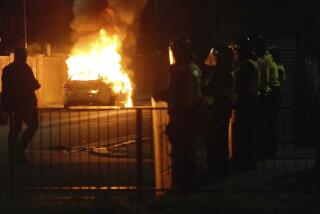Urban Violence : Britain: The Turmoil of Adjustment
- Share via
LONDON — The street paralleling the Broadwater Farm public housing project is quiet now, and there is little evidence of the brief, violent battle that was fought there.
It was not Britain’s first race riot but it was by far its most savage. Disaffected black youths hacked a police officer to death with a machete and, using weapons that ranged from a shotgun to hundreds of Molotov cocktails, injured 230 other London policemen trying to contain the riot.
The ferocity of the violence, and the smoldering anger that lingers among young blacks in the neighborhood where the riot took place Oct. 6, are warnings that Britain’s racial problem has worsened dramatically since the last major outbreak of urban unrest swept the country four years ago.
The Broadwater Farm riot was the latest of three serious inner-city confrontations between minority youths and police that reflect Britain’s painful, uncertain adjustment toward a multiracial society.
Traditional Tolerance
Most white Britons accept this adjustment as inevitable, for this is a nation that has traditionally viewed tolerance and restraint as among its greatest social assets. But the level of tension and anger accompanying it has come as a profound shock.
The vastness of the divide that now separates much of Britain’s urban black population from the national mainstream was driven home by remarks made by the area’s senior elected local official, who not only refused to condemn the rioters but said the police were given “a bloody good hiding.”
Bernie Grant, who emigrated from British Guiana as a teen-ager 22 years ago and, last April, became the first black ever elected to head one of London’s 32 borough governments, complained bitterly about police harassment of blacks. He accused law enforcement authorities of practicing overt, aggressive racism that has steadily worsened.
‘Important Factor’
“I represented the views of the young people,” Grant said when asked about his remarks, “and that was an important factor in defusing the riots.”
The monthlong violence in ethnically mixed, working-class areas of north London, south London and in Birmingham, Britain’s second-largest city, culminating in the riot at Broadwater Farm, has occurred because of confrontations between blacks and the police.
In Birmingham’s economically depressed Handsworth district, violence was set off last month by a parking ticket issued to a black youth leader. The incident triggered two nights of arson and looting that left two post office workers dead, 40 people injured and a model police-community relations program in shambles.
Rioting erupted in the south London suburb of Brixton 18 days later after London policemen accidentally shot a 38-year-old mother of six during a raid on her home in search of one of her sons. The most recent violence, at the Broadwater Farm housing development in the Tottenham area of north London, followed the death of a 49-year-old woman, apparently of a heart attack, in another police raid.
These incidents ignited the volatile mixture of hatred, disillusionment and alienation that has simmered in Britain’s inner cities since the eruption of violence in the summer of 1981.
Exactly what produces these emotions is the subject of intense debate among Britain’s political parties--as is the question of what to do about them.
Prime Minister Margaret Thatcher’s government blames criminal elements and common hoodlums for stoking disaffection as a diversionary tactic to overstretch the police and create conditions more to their advantage.
“The cause is crime, not social conditions,” said Thatcher’s Home Secretary Douglas Hurd, the man responsible for law and order.
Leftists Accused
Some of the prime minister’s supporters accuse militant Communists and other leftist extremists of whipping up emotions to further their revolutionary aims.
So far, Thatcher has responded by authorizing the police to use plastic bullets and tear gas to combat any future disturbances and by proposing to tighten existing public disorder law and impose harsher penalties for those who break it. Her advice to unemployed youth is to get out and look for a job.
On Oct. 11, however, at the Conservative Party’s annual conference, the prime minister spoke in conciliatory tones of the hardship of unemployment and called job creation a primary goal of her government. She pledged tough punishment for rioters but also promised expanded job-training programs.
But leaders of the opposition Labor Party continue to argue that the unrest stems mainly from social deprivation, which has been exacerbated by Thatcher’s tight government-spending policies and by her uncaring image.
Public spending on housing, for example, has declined by nearly two-thirds since she became prime minister in 1979, and central government grants to local authorities for next year will be a quarter less than in 1983.
“This government is completely insensitive to the problems of the inner cities,” said Labor Party leader Neil Kinnock.
75% Unemployment
He and other government opponents note that in Birmingham’s Handsworth district, youth unemployment stands at 75% and that one dwelling in every 11 has no inside toilet.
The Broadwater Farm housing complex, built during the 1960s, was considered a model development and an outstanding example of efforts to create racial harmony. Yet there and in Brixton, the jobless rate among young people is close to 60% and is rising steadily as inner city employment opportunities decline.
But Labor-controlled local governments have often put ideology before pragmatism in confronting these problems. The Lambeth Borough Council, which governs Brixton, refused a major investment that would have brought jobs to the area because the company involved refused to sign a declaration condemning business involvement in South Africa.
Although social scientists and others working with Britain’s inner-city problems believe that hoodlums and outside political agitators may have played a role in the unrest, they are convinced that poor social conditions are at the heart of the trouble.
“If you mix highly concentrated deprived areas with people piled on top of each other in public housing, and you add high unemployment and a racial problem, there is bound to be trouble,” said Victor Hausner, director of an inner cities research program at the Economic and Social Research Council in London.
“A major adjustment in British society is under way,” he said. “These (minority) communities must be incorporated into the mainstream if the country is going to avoid long-term, festering resentment.”
Sense of Hopelessness
Those with contacts among young, urban blacks say the current malaise has helped spawn a sense of hopelessness and despair that is quickly translated into anger.
But there is an additional element to Britain’s racial equation that makes this situation different from the racial upheavals in American cities during the 1960s.
Many young blacks are the children of immigrants who came from the West Indies in the late 1950s and early 1960s to fill jobs in the heavy industries of northern England and service industries in London. As such, the current generation of young blacks is the first to view itself as 100% British, to believe it has a right to equal opportunity, yet is faced with shrinking prospects of getting it.
These are all factors that their parents’ generation did not have to face.
“There is a hard core of young blacks who feel that their elders don’t relate to them, that no one understands,” said Brian Hutchinson, who manages a job creation program in Brixton funded by the British American Tobacco Co. “There is a lot of disillusionment.”
Unlike young Asians of Pakistani, Indian or Bangladeshi origins living in Britain who can fall back on extended families that often can provide a job as well as a social haven, young blacks have no such safety net.
Race problems are relatively recent for Britain. Before World War II, the country’s nonwhites accounted for less than 1% of the population.
Immigration Curtailed
Political upheaval in East Africa brought a large influx of ethnic Asians to Britain in the 1960s and early 1970s; the main immigration of West Indians came in the 1960s. Since the late 1970s, immigration of all nonwhites has been curtailed. They now make up just over 6% of the population, which totals 56 million. By comparison, nonwhites make up roughly a quarter of the U.S. population.
The task of bringing Britain’s disaffected young blacks into the mainstream is seen as vital for the long term. Until the recent trouble, the recommendations of a commission that looked into the 1981 riots were seen as part of the solution. This was the Scarman Commission, headed by Lord Scarman, a respected judge, and its central recommendation, for closer police-community relations, had been implemented.
Although the Thatcher government has reduced overall local government spending, it has spent $2.3 billion on a special urban renewal program, and the inner cities seemed calm--until last month.
Senior police officials at Scotland Yard say it is still too early to assess the damage the recent riots caused to their community relations programs. Supt. Ray Tanner, who is involved in London’s community relations program, said it will be reviewed closely. And he talked of greater efforts to recruit more black police officers--there are only 250 in a force of 27,000.
Well-Known Restraint
Other senior police officers expressed concern that younger officers might become hardened by continued violence and lose the restraint for which Britain’s police are so well known. A police force that historically has confronted social unrest with little more than discipline and stern looks has now been shot at and, for the first time, it has something to shoot back with.
Improvements in inner-city education and housing are painfully slow, and the outlook for resolving unemployment is bleak. Even with the current economic upswing, the jobless rate last month rose to a record 13.9% nationally. Few see any short-term improvement.
And even if unemployment should drop, young urban blacks are likely to be the last to benefit. Although there is little enthusiasm in Britain for affirmative action programs like those that have broken down job barriers for blacks in many areas of the United States, there are those who feel that such steps may now be necessary.
“What has happened . . . is not a minor setback,” Hausner, the researcher, said. “It is a serious reminder that four years later, much more needs to be done.”
More to Read
Sign up for Essential California
The most important California stories and recommendations in your inbox every morning.
You may occasionally receive promotional content from the Los Angeles Times.













